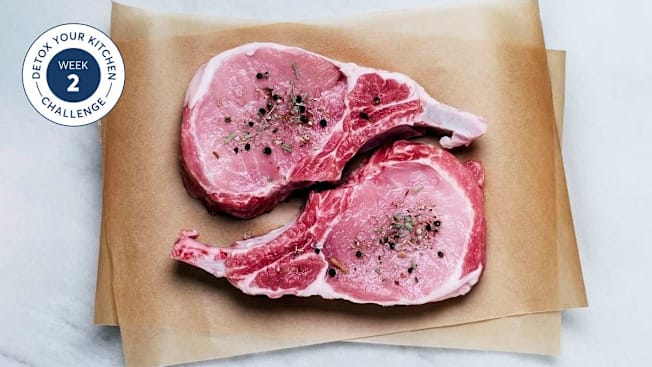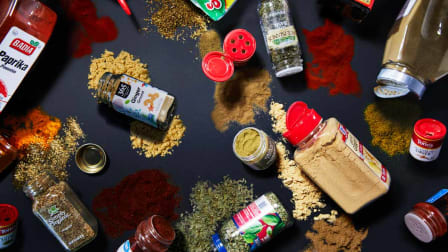How to Shop for Safer, Healthier Meat
In Week 2 of our Detox Your Kitchen Challenge, we have advice about minimizing your exposure to pesticides, drugs, and harmful bacteria in beef, pork, and poultry

Consumer Reports has partnered with The Guardian US to create this seven-week Detox Your Kitchen Challenge.
Each Fourth of July, neighbors flock to your backyard. Brats, burgers, wings—everyone knows you can run a ’cue. But as the food sizzles, you recall that recent news about an E. coli outbreak. Then you remember the neighbor who told you about substances like hormones, pesticides, and antibiotics widely used in raising food animals. And what was that about a “factory farm”?
You start to wonder—should you have used organic meat or thrown a vegan barbecue?
There’s a lot to figure out as—according to a federal study—meat and poultry contribute to more deaths than any other category of food. But finding safer protein is easy: You just have to know where to look and what to look out for. I’ve been writing about organic food and toxic chemicals for years, and I can help you out with a few simple tips.
What May Lurk in Your Meat
Briefly consider the life of a nonorganic cow that becomes a burger. It likely ate feed or grass sprayed with pesticides. Among the most common is chlorpyrifos, a substance linked to neurodevelopmental harm in children that the Environmental Protection Agency banned until a court overturned it.
Check Out Other Installments in the Detox Your Kitchen Challenge
Week 1: Nix the Pesticides in Your Food. Week 3: How to Lower Your Risk From the Chemicals in Seafood. Week 4: What You Can Do About Microplastics in Your Food. Week 5: Clean Up Your Tap Water. Week 6: Opt for Safer Kitchenware. Week 7: Safer Ways to Clean Your Kitchen.
Finding Safer Meat
In contrast to industrial farms, the best organic farms offer ample space for cows to graze on bucolic pastures. The animals and their food are free from most synthetic fertilizers, pesticides, hormones, and genetically modified organisms (GMOs). Animals aren’t given antibiotics to prevent disease; they’re treated if they become ill, but then the meat isn’t sold as organic.
In short, they live like cows are supposed to on something similar to what most people imagine a farm to be.
It’s impossible for most consumers to figure out what goes on behind barn doors, but the Cornucopia Institute, an independent organic industry watchdog, does that for you. It developed excellent scorecards that rank most of the nation’s organic beef, poultry, egg, and dairy producers based on metrics around animal welfare, transparency, pasture management, and other indicators that will point you to well-run organic farms.
I rely heavily on it for navigating the minefield. Checking brands in its searchable database is easy while standing at a grocery store meat case. Organic beef or poultry is generally safer than conventional, but Cornucopia deciphers between “industrial organic,” where animals aren’t raised with chemicals, hormones, or antibiotics, and “authentic organic.” The latter goes beyond the Department of Agriculture’s organic seal requirements for animal welfare, grazing practices, and environmental sustainability.
As far as nationally distributed brands go, Panorama Organic beef, Bell & Evans chicken, Vital Farms eggs, and dairy products from Maple Hill Creamery did well in Cornucopia’s rankings.
You can also look at seals and certifications on packaging. CR’s seal guide gives the highest ratings to American Grassfed, Animal Welfare Approved, Non-GMO Project Verified and USDA Organic.
Another surefire solution: Eat meat at fewer meals, have smaller portions, and throw a few veggie dogs on the grill.
Don't Let Meat Make You Sick
Cooking meat and poultry thoroughly is the simplest and best way to kill salmonella and E. coli. You can’t gauge whether meat is fully cooked by how it looks. Instead, check the internal temperature with a thermometer. Ground beef and pork are safe when cooked to 160° F. Poultry—ground, whole, and parts—should be cooked to 165°F; beef roasts and steaks, and pork roasts and chops, to 145°F.
Buying organic may help avoid certain dangerous bacteria. CR in 2022 didn’t find much of a difference between bacteria levels in organic ground meat vs. conventional ground meat, though other research has found lower levels in organic.
And there have been further changes for the better. New organic animal welfare and processing rules that begin to go into effect this year require more space for the animals and better management practices. Bacteria levels in meat fell following the implementation of similar guidelines in the European Union.
You've Got Questions, We Have Answers
What can I do instead of buying meat and poultry from a supermarket?
Go to your local butcher or farmers market and ask a few questions about the way they raise their animals. It’s a great opportunity to learn about how the food you’re eating is produced. Use that information in the context of what you’ve learned here to inform your purchases. The National Sustainable Agriculture Coalition created a great guide during the pandemic for connecting consumers with local producers.
Should I choose meat with labels that have terms like “grass-fed,” “vegetarian-fed,” or “pasture-raised”?
Some terms, like “vegetarian diet,” don’t have a legal definition and are often meaningless marketing slogans. (A chicken’s natural diet isn’t vegetarian, by the way.)
And terms like “pasture-raised” may sound great, but producers are largely left to define “pasture” how they want to. Nonorganic egg producers can label chickens raised in screened-in porches as pasture raised, for example.
Finally, remember that not all “grass-fed” claims are created equal. The independently certified American Grassfed seal is more meaningful than the USDA’s “grass-fed” label because it holds producers to higher standards.
Goals for the Week
• Are you making a dish with beef or chicken for dinner this week? Consider buying organic. To make that more budget-friendly, you can have a smaller portion and round out your meal with whole grains and vegetables, which are better for your health anyway.
• Add two sites to your phone’s bookmarks: Cornucopia’s organic meat scorecards, so you can look up brands while you’re at the store, and CR’s seal guide, so you know which seals on meat packaging are trustworthy.
• If you want to kick your goals up a notch, try buying meat from a butcher or farmers market and ask a few questions. Are any pesticides, antibiotics, hormones, or other substances used to produce the meat? Make your decision based on the response.




















